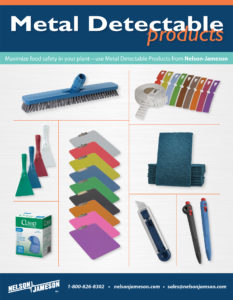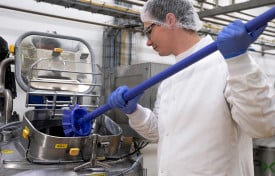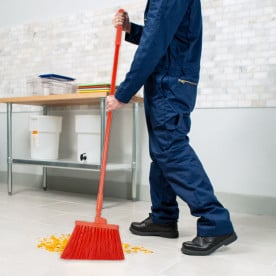A critical component in food safety is the detection of contaminants. One of the worst nightmares of anyone working in food processing, is finding something in the final product that is not supposed to be there. This can cause costly product loss, clean-up and maintenance costs, and the potential for recalls and/or litigation. Even though everyone tries to prevent foreign object contamination, pieces of tools such as scrapers can break off, or items such as pens can fall into the product. To make sure that these items are caught, and that contaminated product does not make it out the door, many plants utilize metal detection devices and products.
Metal detectable products are constructed of a few different materials. They are often blue for easy visual detection. Blue is also the most common non-food color. Metal detectable products are made through a unique manufacturing process that involves the inclusion of a metallic pigment. This enables the plastic to be detected. In some objects such as earplugs, a stainless steel ball bearing is enclosed in the plug, making them detectable. A product with embedded metal is only detectable if the product piece containing the metal goes through a detector. With a product that is impregnated, the entire piece has fine metal particles throughout, making the entire piece, or parts of it, detectable.
Metal detectable products are made through a unique manufacturing process that involves the inclusion of a metallic pigment. This enables the plastic to be detected. In some objects such as earplugs, a stainless steel ball bearing is enclosed in the plug, making them detectable. A product with embedded metal is only detectable if the product piece containing the metal goes through a detector. With a product that is impregnated, the entire piece has fine metal particles throughout, making the entire piece, or parts of it, detectable.
Metal detectable calibration is an important aspect of a metal detectable program. To maintain calibration, you should periodically check calibration by passing a known calibration test tool under the unit to check for accuracy. Test tools can be made of ferrous, non-ferrous, or stainless steel and include rods, cylinders, balls, whips, cards, and more. Depending on the food being produced, machine calibration must be adjusted and set to a threshold that is determined by the company in regards to the size of contaminant they want the detector to reject. Many things affect the setting of the machine including whether the food is wet or dry, its size, and its speed. If you don’t test your calibration, the metal detector can allow larger pieces of foreign object contaminant to get through than the threshold setting, which threatens the finished product’s safety.
Nelson-Jameson can help you start or expand your Metal Detectable program with our wide range of products. Our new Metal Detectable Flyer features 32 pages of products ranging from writing utensils and office supplies to calibration tools and scrapers. We also have metal detection and x-ray equipment from Valcour Process Technologies to help enhance your program. Request your free copy of our flyer, or visit our website to download it today!







